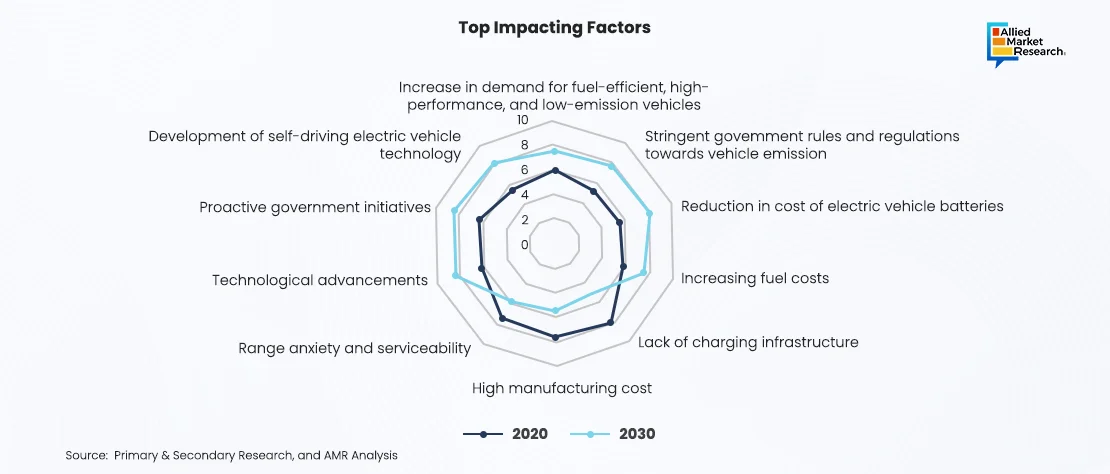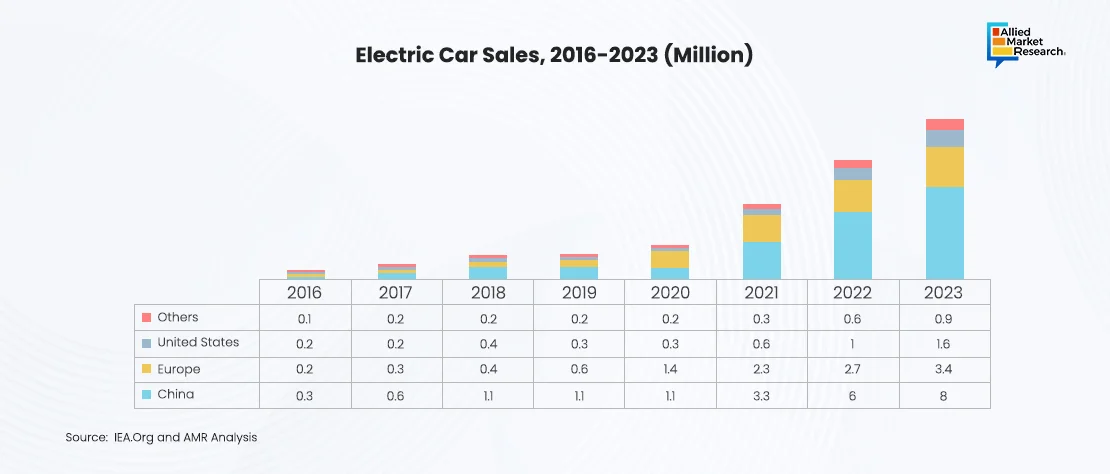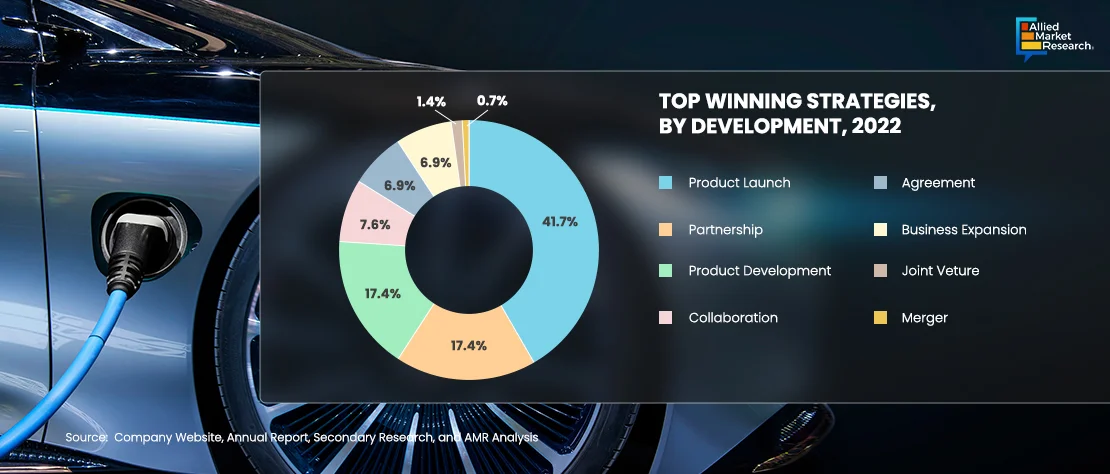Table Of Contents

Lalit Janardhan Katare

Pooja Parvatkar
Electric Vehicles: The New-age Preferred Drive

The automotive industry has undergone transformation, marked by the onset of several technological, societal, and environmental trends that have reshaped the way we think about transportation. From the rise of electric vehicles & autonomous driving technologies to the surge in emphasis on sustainability and connectivity, these trends have revolutionized every aspect of the automotive ecosystem.
An electric vehicle operates on electricity unlike its counterpart, which runs on fuel. Instead of internal combustion engines, these vehicles run on an electric motor that requires constant supply of energy from batteries to operate. Several varieties of batteries are used in these vehicles. These include lithium ion, molten salt, zinc-air, and various nickel-based designs. EVs were primarily designed to replace conventional means of travel as they lead to environmental pollution. EVs have gained popularity owing to numerous technological advancements. It outperforms the conventional vehicle providing higher fuel economy, low carbon emission & maintenance, convenience of charging at home, smoother drive, and reduced sound from engine. Three types of EVs are available in the industry, battery, hybrid, and plug-in hybrid electric vehicles. In addition, electric vehicles require no engine oil changes, however, they are slightly more expensive than their gasoline equivalents.
Emergence of EVs as a Sustainable Alternative
EV technology operates on the principle of converting electrical energy stored in batteries into mechanical energy to propel the vehicle. At the core of an EV is its electric motor, the primary propulsion system. When the driver activates the accelerator, electricity from the battery pack is delivered to the electric motor, causing it to generate rotational motion. This rotational motion is then transmitted to the wheels, propelling the vehicle forward. Unlike traditional internal combustion engines, electric motors have fewer moving parts, resulting in reduced maintenance and higher efficiency. The energy to power these motors is stored in high-voltage battery packs, typically composed of lithium-ion cells. These batteries are charged through various methods, such as plugging into a charging station or utilizing regenerative braking, which captures energy during deceleration and stores it back into the battery. Overall, EV technology offers a cleaner, more sustainable alternative to traditional gasoline-powered vehicles, with the potential to revolutionize transportation and reduce dependence on fossil fuels.

Factors such as increase in demand for fuel-efficient, high-performance, & low-emission vehicles, stringent government rules & regulations toward vehicle emission along with reduction in cost of electric vehicle batteries and increase in fuel costs supplement the growth of the EV industry. According to the International Global Electric Vehicle Outlook of Energy Agency, global sales of electric cars surpassed 10 million units in 2022. Moreover, the report projects a further 35% growth in sales for the year 2023, with an estimated 14 million electric cars expected to be sold worldwide. Furthermore, by 2030, electric vehicles (EVs) are projected to make up more than 10% of the total road vehicle fleet. The sales of EVs are expected to exceed 20 million units in 2025 and surpass 40 million units in 2030. These figures represent over 20% and 30% of all vehicle sales worldwide, respectively. Therefore, the demand for fuel efficient vehicles has increased, owing to the rise in the price of petrol and diesel. This is attributed to the depletion of fossil fuel reserves and environmental concerns. Thus, these factors boost the need for advanced fuel-efficient technologies, leading to a surge in demand for electrically powered vehicles, which, in turn, propels the demand for electric vehicle chargers.
Moreover, factors such as lack of charging infrastructure, high manufacturing cost, and range anxiety & serviceability are the factors expected to hamper the growth of the electric vehicle market. Furthermore, factors such as technological advancements, proactive government initiatives, and development of self-driving electric vehicle technology are expected to create many opportunities for the growth of the electric vehicle market.
Increase in vehicle population and rise in vehicle standards fuel growth of the Asia-Pacific sector. Moreover, various technological advancements related to electric vehicles have taken place owing to government initiatives, which further propel the growth of this sector. In addition, countries such as China, India, Australia, and Japan are focused on environmental awareness and innovative technologies, which drives growth of high-performance electric vehicle industry. Moreover, factors such as a significant rise in income levels and urbanization in emerging countries of Asia-Pacific augment the growth for the electric vehicle market. In addition, emission regulations and the subsidies for hybrid & electric vehicles in Asia-Pacific have helped the region achieve a major portion of the overall EV industry. Passenger electric vehicles have gained popularity among consumers by proactive participation of automotive OEMs. According to the IEA Global EV Outlook report, General Motors and Volkswagen have intensified their efforts in China & are expected to lead the sector in 2030, with around 57% share of the industry.

With rise in environmental concerns, European governments and environmental agencies have enacted stringent emission norms and laws that increase demand for electric vehicles in Europe. For instance, in Europe, the European Union (EU) has committed to achieving its 20% greenhouse gas reduction target in 2020 for the second phase of the Kyoto Protocol. By 2050, the EU aims to achieve the target of 0% greenhouse gas emission. The regulation EU 253/2014 sets the target of 147 gm of carbon dioxide emission per kilometer for 2020 and 2021, for commercial vehicles, based on the NEDC (New European Driving Cycle) test procedure. In addition, the European Union set a target of 31% reduction of carbon dioxide emission for Light Commercial Vehicles (LCVs) by 2030. In addition, the region is home to electric truck manufacturers such as Volvo & Daimler, and the diesel bans & other emission regulations have forced vehicle manufacturers to include electric vehicles in their product offerings in Europe. Therefore, technological advancements and growth in vehicle standards such as strict emission limits contribute toward growth of the electric vehicle market in Europe. The prevalence of various vehicle emission protocols forces manufacturers to manufacture technically advanced, low-cost, and lightweight electric vehicles. High disposable income, rise in prevalence of Europe safety protocols, and vehicle standards drive the industry growth in this region.
North America dominates the electric vehicle market and has major players that offer advanced automobile electrification solutions. The region occupied a major share of the global electric industry in recent years, and is expected to lead the sector, in terms of adoption of electric vehicles. This is attributed to the extensive adoption of advanced electric vehicles and growth in public demand for fuel-efficient & eco-friendly vehicles. Moreover, strong public charging infrastructure further supplements the growth of electric vehicle market in North America. For instance, in July 2018, according to the Center of American Progress, there are 18,000 charging stations for EVs, which is expected to increase to reach 330,000 charging outlets by the year 2025.
Development Strategies of Key Players
Companies have adopted product development and product launch as their key development strategies in the electric vehicle market. The key players in this electric vehicle market are Ampere Vehicles, Benling India Energy and Technology Pvt Ltd, BMW AG, BYD Company Limited, Chevrolet Motor Company, Daimler AG, Energica Motor Company S.p.A., Ford Motor Company, General Motors, Hero Electric, Hyundai Motor Company, Karma Automotive, Kia Corporation, Lucid Group, Inc., Mahindra Electric Mobility Limited, NIO, Nissan Motors Co., Ltd., Okinawa Autotech Pvt. Ltd., Rivain, Tata Motors, Tesla, Inc., Toyota Motor Corporation, Volkswagen AG, WM Motor, and Xiaopeng Motors. Automobile companies focus on the production of advanced and low-maintenance electric vehicles, which have low particulate emissions. For instance, Hyundai launched an electric variant Ioniq 5 in 2023, whereas Mahindra launched its XUV 400 EV in 2023.

The electric vehicle ecosystem offers significant opportunities for stakeholders across the ecosystem. For instance, as per Allied Market Research, the total addressable market (TAM) for different verticals of electric ecosystem is as below.
- The global electric vehicle market was valued at $163.01 billion in 2020, and is projected to reach $823.75 billion by 2030, registering a CAGR of 18.2% from 2021 to 2030.
- The global electric vehicle charger market size was valued at $7.2 billion in 2022, and is projected to reach $91.2 billion by 2032, growing at a CAGR of 29.3% from 2023 to 2032.
- The global electric vehicle supply equipment (EVSE) market was valued at $2.12 billion in 2020, and is projected to reach $20.84 billion by 2030, registering a CAGR of 25.9%. from 2021-2030.
- The global electric vehicle battery market size was valued at $23.8 billion in 2021, and is projected to reach $108.2 billion by 2031, growing at a CAGR of 16.6% from 2022 to 2031.
- The global electric vehicle motor market size was valued at $24.9 billion in 2022, and is projected to reach $99.5 billion by 2032, growing at a CAGR of 15.2% from 2023 to 2032.
EVs to evolve as a popular choice among vehicle owners
The electric vehicle market is on the brink of a transformative era, with a promising outlook that reflects both technological innovation and shift in consumer preferences. As advancements in battery technology continue to improve driving range and reduce costs, and as governments worldwide implement policies to support EV adoption, the industry is expected to witness significant growth. Moreover, surge in focus on sustainability and environmental consciousness foster demand for cleaner transportation solutions, further boosting the appeal of electric vehicles. With established automakers and new entrants investing heavily in EV development, and with infrastructure for charging & energy storage expanding rapidly, the stage is set for electric vehicles to become the dominant form of transportation in the years to come. As the industry continues to evolve, it is essential for stakeholders to collaborate and innovate, ensuring that electric vehicles fulfill their potential as a sustainable, efficient, and accessible mode of transportation for generations to come.
For further insights, get in touch with AMR analysts. -Call for assistance (alliedmarketresearch.com)

